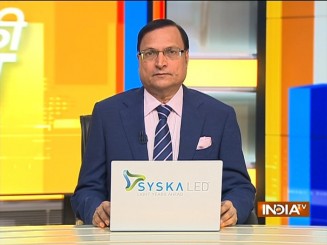 At a time when Maharashtra’s coalition government is yet to decide on how to deal with the ‘azaan’ loudspeaker issue raised by MNS chief Raj Thackeray, despite calling an all-party meeting, Uttar Pradesh chief minister Yogi Adityanath’s government has shown the way.
At a time when Maharashtra’s coalition government is yet to decide on how to deal with the ‘azaan’ loudspeaker issue raised by MNS chief Raj Thackeray, despite calling an all-party meeting, Uttar Pradesh chief minister Yogi Adityanath’s government has shown the way.
Amid the raging controversy over use of loudspeakers for ‘azaan’(call for prayers) from mosques and recital of bhajans from temples and other religious places, the UP additional chief secretary (home) on Monday issued an order giving a deadline of April 30 for removal of all illegal loudspeakers from religious shrines. This order has done the trick. There are reports of imams and priests removing loudspeakers on their own from mosques and temples.
The order came five days after UP chief minister Yogi Adityanath said loudspeakers can be used at religious places with prior permission but the sound must be so low that it should not come out of the premises. He also said, no new permission shall be used for installing loudspeakers.
The UP government’s order directed all police stations to make a list of all such religious places and send their reports to the home department by April 30. All illegally installed loudspeakers shall be removed after consultations with religious leaders. The order had a positive effect. By Monday, in more than 38,000 mosques and temples spread across UP, the volume of loudspeakers has been considerably reduced to permissible limit. In not a single instance was any loudspeaker forcibly removed by police. In all, 6,031 illegally installed loudspeakers have been removed till Wednesday afternoon, while sound volume of 29,674 loudspeakers have been reduced considerably.
Yogi Adityanath launched the initiative from his own temple, the famous Gorakhnath Mandir in Gorakhpur. All loudspeakers at the shrine which faced outwards, have now been turned inwards, so that sound does not travel to outside localities. The volume has been turned down to 45 decibel limit. This had an effect on the management of Badi Jama Masjid in Gorakhpur. The chief imam of the mosque also turned down the volume of loudspeakers.
Yogi’s initiative had a sobering effect on all other religious shrines in UP, where the managements, on their own, reduced the sound volume of the loudspeakers. Several mosques have removed loudspeakers that were installed illegally.
Our Lucknow reporter Ruchi Kumar says, loudspeakers have been removed from 778 religious place so far. Out of these, 711 loudspeakers were removed in Lucknow zone, 30 in Agra zone, 19 in Gautam Buddha Nagar zone, 13 in Kanpur zone, two in Meerut zone, and one each in Bareilly, Prayagraj and Varanasi zone. Similarly, sound volume of loudspeakers in more than 21,000 religious places were reduced across UP. Out of them 5,469 religious places are in Bareilly zone, 4,803 in Lucknow zone, 4,711 in Meerut zone, 2,354 in Gorakhpur zone, and 1,073 in Prayagraj zone, where sound volume of loudspeakers were reduced.
As a first step, local police officials spoke to the managements of mosques and temples and informed them about Supreme Court guidelines on permissible sound limit. Soon after, teams went around to check the number of loudspeakers and the sound limit of loudspeakers installed in temples and mosques. Those who have violated guidelines are being given notices.
At the Roshan Ali mosque in Kaiserbagh, Lucknow, four loudspeakers were installed. Three loudspeakers were removed after police issued notice and the volume of the fourth loudspeaker was reduced. The imams and priests are being told by police how to keep a watch on the sound decibel limit of loudspeakers, and most of them are complying.
India TV reporter visited the Markaz Masjid in Ghaziabad on Tuesday and found that out of the four loudspeakers which had been installed there, one has been removed, two have been closed down, and the fourth loudspeaker is being used for ‘azaan’ within permissible limit. At the famous Doodheshwar Nath Mandir in Ghaziabad, the mahant has closed down all four loudspeakers. Only conch shells, bells and gongs are being used during ‘aarti’ prayers.
At the Jama Masjid in Noida, India TV reporter spoke to the imam, who said that volume of loudspeakers has been reduced, and after Ramzan and Eid-ul Fitr are over, the sound limit will be reduced considerably. In Badagaon, Jhansi, loudspeaker was first removed from the main temple, and the imam of the adjoining mosque too removed his loudspeaker.
One significant point that needs to be taken note of is that no arm-twisting has taken place in UP, and the guidelines are being equally applied to both mosques and temples. When a government acts impartially, it has a positive effect. People’s trust in the administration gets strengthened and they come forward on their own to implement the sound pollution guidelines.
Chief Minister Yogi Adityanath is himself the Goraksha Peethadishwara (chief of Goraksha Peeth). He himself reduced the sound level of loudspeakers installed in his religious shrine, and this was taken as a positive sign by the imams and priests of both mosques and temples. Of course, wherever hard action is required, Yogi does not hesitate. Whether it is bulldozing ill-gotten properties of gangsters and criminals or throwing them inside jails. On the loudspeaker issue, he pursued the path of love and conciliation.
The moot point is, Yogi did not differentiate between communities or religions, either on the issue of loudspeakers or on dealing with gangsters. Other state governments should learn from Yogi.